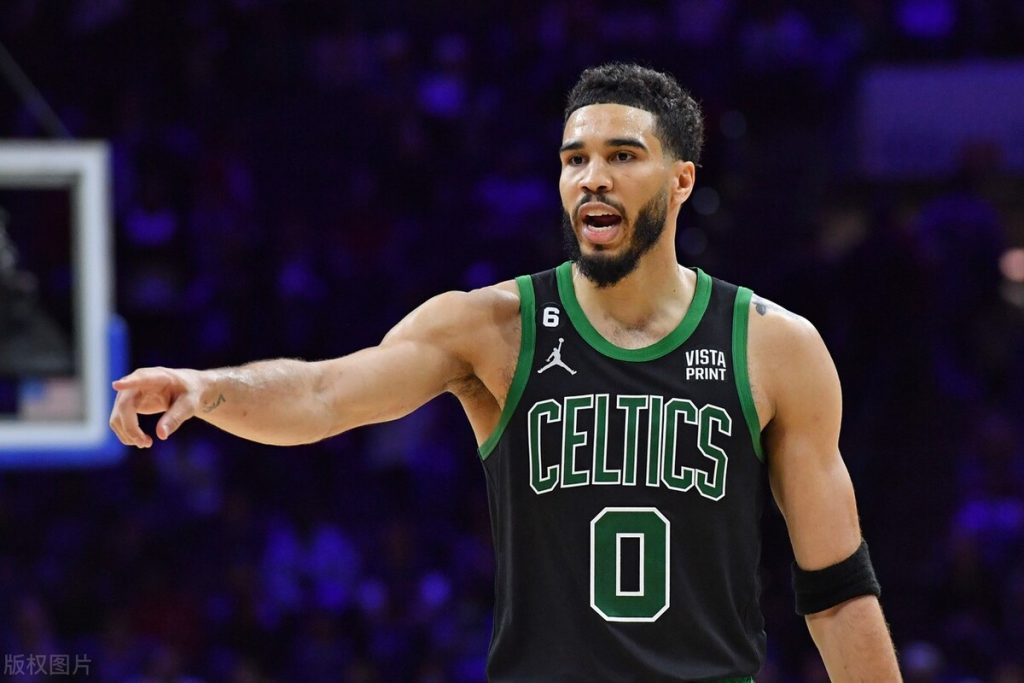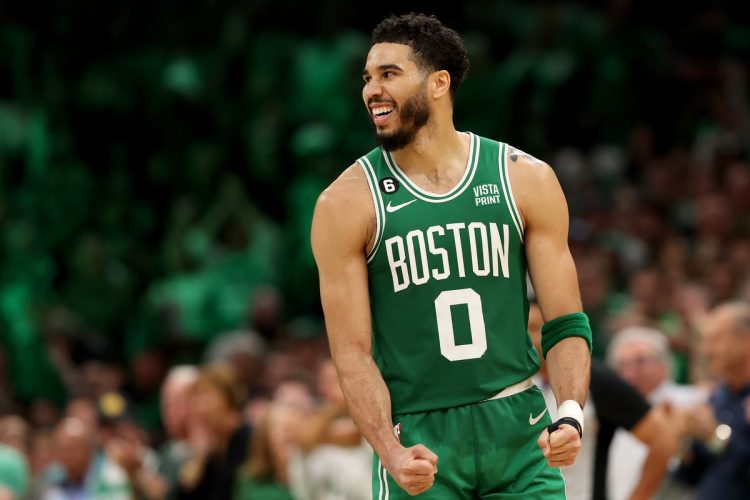Jayson Tatum, the Boston Celtics’ superstar forward, has rapidly emerged as one of the NBA’s brightest young talents. Since being selected with the third overall pick in the 2017 NBA Draft, Tatum has evolved from a promising prospect to the cornerstone of the Celtics’ franchise. His unique blend of size, skill, and basketball IQ has not only reshaped his individual game but also redefined the Boston Celtics’ offensive strategy in ways that have significantly impacted the team’s success in recent years.
Tatum’s rise to stardom has been accompanied by a noticeable shift in how the Celtics play offensively, marking a departure from their traditional reliance on a balanced team approach to a more perimeter-oriented, isolation-heavy style of play. This article will examine how Jayson Tatum’s evolution as a player has transformed the Celtics’ offensive system and what this means for the future of the team.
1. Jayson Tatum: A Superstar in the Making
From the moment he entered the league, Tatum showcased a rare combination of scoring ability, basketball IQ, and maturity for his age. While other rookies may have struggled with the demands of the NBA, Tatum quickly earned the trust of his coaches and teammates with his all-around game. By his second season, Tatum had already established himself as a primary scoring option for the Celtics, averaging 15.7 points per game. However, it was in his third and fourth seasons where he truly blossomed, developing into one of the league’s premier offensive players.
A. The Offensive Growth
Tatum’s offensive growth is a testament to his hard work and adaptability. Known for his silky smooth jump shot, he has refined his ability to score from all areas of the court—whether it’s the three-point line, mid-range, or at the basket. His signature step-back jump shot, combined with his ability to finish around the rim, makes him an offensive nightmare for defenders.
But Tatum’s offensive game isn’t limited to just scoring. Over the years, he has developed a more complete offensive repertoire. His ability to read defenses and make smart decisions, whether it’s finding the open man or taking it to the hoop, has added another layer to his game. He isn’t just a scorer; he has become a playmaker, averaging career-high assist numbers in the past few seasons.
B. Becoming the Celtics’ Offensive Leader
As Tatum’s offensive abilities have flourished, he has taken on a leadership role within the Celtics’ offense. The Celtics’ offensive approach has increasingly been built around his talents, making him the focal point of their system. In the past, Boston was known for having a more balanced, team-oriented offense, but as Tatum developed into a top-tier scorer, the team began to center their offensive strategy around his individual strengths.
2. The Evolution of the Celtics’ Offensive Strategy
In recent seasons, it has become clear that the Celtics’ offensive system has shifted significantly to accommodate Tatum’s growing skill set. Under head coach Ime Udoka (and later, Joe Mazzulla), the team’s offense has adapted to the unique abilities of their young star, with Tatum leading the charge.
A. The Rise of the Isolation Game
One of the most significant changes in the Celtics’ offensive strategy has been the increase in isolation plays run for Tatum. While Boston’s offense had traditionally leaned on ball movement and team play, the Celtics have increasingly turned to Tatum’s isolation abilities to create scoring opportunities. Tatum, with his size (6’8″) and skill, can generate mismatches against almost any defender, making him a deadly weapon in isolation situations.
In isolation, Tatum’s ability to create his own shot is unmatched. His pull-up jumper, combined with his crafty footwork and change of pace, allows him to break down defenders one-on-one. This style of play has become central to the Celtics’ offensive identity, especially in clutch moments when they need a go-to scorer. Tatum has proven time and again that he can deliver in the final minutes of games, often taking over when the team needs him most.
B. The Perimeter-Oriented Offense
As Tatum has become a more prolific three-point shooter, the Celtics’ offense has also shifted toward a more perimeter-oriented style. While Tatum was initially more known for his mid-range game and ability to score inside, his improvement as a three-point shooter has transformed him into a legitimate scoring threat from anywhere on the floor.
His development from a “mid-range shooter” to a player who can stretch defenses with his three-point shooting has forced defenders to respect his range. This has opened up more space for him to attack the basket or pull up for long-range shots. Tatum’s ability to space the floor has allowed his teammates—particularly other shooters like Jaylen Brown, Marcus Smart, and Al Horford—to get more open looks.
As a result, the Celtics have increasingly relied on a spread-the-floor approach, utilizing pick-and-roll actions with Tatum as the primary ball handler. The spacing created by Tatum’s shooting threat has made the offense more fluid, with players moving around him to either catch and shoot or attack the rim.
3. Tatum’s Impact on the Celtics’ Supporting Cast
Jayson Tatum’s development as a player has not only impacted his own game but also the performance of his teammates. His offensive versatility has allowed the Celtics to build a more dynamic and adaptable system.
A. Jaylen Brown: A Perfect Running Mate
The tandem of Tatum and Jaylen Brown has become one of the most dangerous duos in the league. Both players are capable of scoring in a variety of ways, and their chemistry has been central to the Celtics’ offensive success. With Tatum commanding defensive attention, Brown often benefits from increased opportunities to attack in isolation or catch-and-shoot situations.
As Tatum’s offensive growth continues, it creates more space for Brown to work and thrive. The two players complement each other in a way that allows Boston to field one of the most potent offenses in the NBA, often running plays designed to get both players open looks.
B. Playmaking and the Role of Point Guard
Tatum’s improved playmaking skills have also had a positive impact on the Celtics’ offense. While he is primarily known as a scorer, Tatum’s ability to create for others has helped relieve pressure on Boston’s point guards, such as Marcus Smart, who has had to take on a larger playmaking role.
Tatum’s playmaking abilities help open up options for his teammates, particularly in pick-and-roll situations where he can either shoot or pass to a rolling big man or an open shooter on the perimeter. His ability to handle the ball and make decisions in real time has made him an even more complete offensive weapon.

4. The Celtics’ Championship Contention
With Tatum as the centerpiece, the Celtics’ offensive philosophy has evolved to reflect his capabilities. The shift towards a more isolation-heavy, perimeter-oriented offense has made them one of the more formidable teams in the league, capable of competing with the best of the best. However, as Boston continues to adjust its offensive scheme around Tatum’s growing skill set, the question remains: Can they turn this offensive prowess into a championship?
The answer depends not only on Tatum’s continued development but also on the team’s ability to execute in critical moments. While the Celtics have a talented roster, the question of how they can balance offense and defense, and whether they can become more consistent in the postseason, will ultimately determine whether they can win a championship during Tatum’s prime years.
Tatum’s leadership will be pivotal in these moments, as his ability to elevate his game in the playoffs will be the difference between a deep run and an early exit. The Celtics’ offense, with Tatum at the helm, will continue to be their strength, but the team will need to find ways to complement it with strong defense and team chemistry.
5. Conclusion: A New Era for the Celtics
Jayson Tatum’s rise as an offensive powerhouse has unquestionably altered the course of the Boston Celtics’ offense. What was once a team-oriented system based on passing and movement has now been reshaped around Tatum’s scoring ability and basketball IQ. His evolution into one of the NBA’s elite players has allowed the Celtics to pivot to a more isolation-heavy, perimeter-oriented offensive system that maximizes his strengths.
As Tatum continues to mature and refine his game, the Celtics will look to him not only to lead them offensively but also to carry them toward championship contention. The future of the Celtics is firmly in his hands, and if his growth continues at this pace, the team’s offensive identity will only become more potent and more difficult to defend.
In a league dominated by superstars, Jayson Tatum has already proven that he belongs in the conversation. The Celtics’ offensive future is as bright as ever with him leading the way.


































Discussion about this post